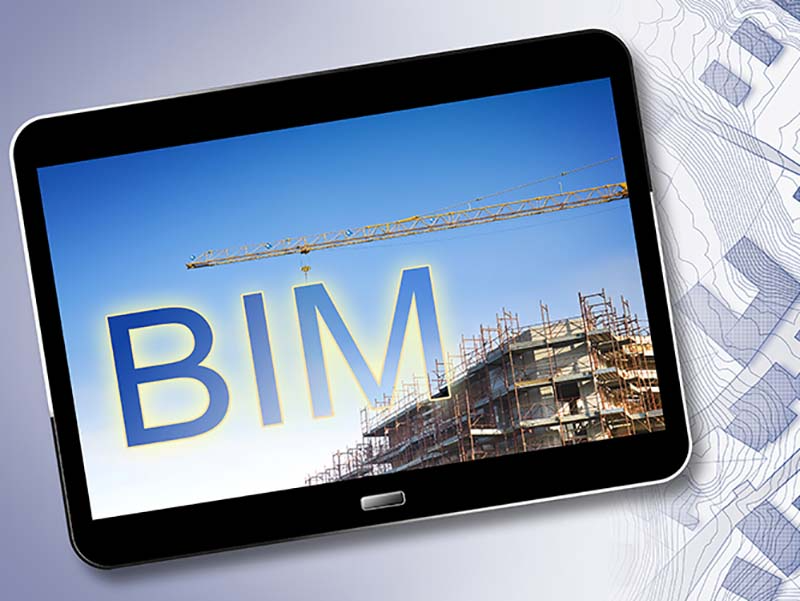A BIM model
Implementation of BIM requires leadership
A decade ago, it was normal to challenge the concepts and values of BIM. We are now, however, in a very different phase. BIM is widespread across the industry, with its benefits being recognized by many and in a vast number of ways. The BIM era has been driven not only by the 2016 government mandate but also a general momentum from organizations throughout the industry, for example design teams and contractors using their own initiative to recognize efficiencies through the adoption of BIM. It’s time for everyone to start (or continue) their BIM journey and craft the direction and pace of these to benefit the company and clients. This, however, is easier said than done! Though these standards have been produced to drive us forward into a new era of information production, exchange, management and delivery; all should be aware that meeting the requirements will not be simple. The BIM process stimulates change, an uptick in process management, an increased need for competent and trained personnel, and a wider awareness and consideration of one’s position within the wider project lifecycle. As such, implementation of BIM requires leadership, a team with common and clear goals, and a mechanism to celebrate progression.
Use of BIM standards.
Progression along the BIM journey
Aside from the normal barriers for implementing change within a business, additional barriers exist when implementing BIM. One of the key barriers relates to the creation of a new ‘alien’ information workflow and its associated protocols and documents, as well as hundreds of ‘TLAs’ (Three Letter Abbreviations!) It’s completely normal for the glossary of a typical BIM document, such as a BIM Execution Plan, to be two or three pages long; therefore, aside from encouraging all to progressively become familiar with the terminology, it is prudent to have BIM champions within a company to provide support for wider business. Paul Shillcock, co-author of the PAS 1192-2 standard (and accompanying UK National Annex) has stated that “there will be a need for both the providers and receivers of information to transform the way in which they produce, exchange and use digital information, whilst aligning their business process to the latest industry standards and best practice.” (BIMPlus, 2019) In our experience at Plowman Craven, one of the most effective ways of progressing along the BIM journey is to practise it. As each project progresses, lessons are learnt (in line with BS EN ISO 19650 vision), and best practice is progressively developed. Progression on the BIM journey can be seen in many ways, whether that’s the evolution of a common data environment, the optimization of an internal workflow, the appropriate allocation of roles and responsibilities, or even the ‘back-to-basics’ technique of communication!
Project lifecycle
Compared to traditional projects, BIM advocates an increased frequency of information exchange throughout the project lifecycle. The challenge is that many disciplines work in many applications and therefore information interoperability is not always easy. This is, however, possible with open format file types like IFC. These can be exported and imported into most authoring and reviewing platforms and therefore provide a key information link between specific task teams. For example, when a design has been detailed and the subcontractor then takes ownership of it, the designer can collaborate cross-platform, therefore enabling the subcontractor to pick up from where they left off. This alone provides a significant programme saving as the subcontractor no longer needs to recreate the design intent information. The BS EN ISO 19650 strongly advocates the importance of interoperable data formats, like the IFC. As per clause 5.1.6 of BS EN ISO 19650-2:2018, “using open data standards whenever possible to avoid duplication of effort and interoperability issues.” (BSI Standards Limited, 2018) The NBS National BIM report 2019 indicates that 77% of individuals use the IFC format within their project. (NBS, 2019). This illustrates a key step not only in industry mindset progression but also the start of a new, next level, collaboration era.
Use of the IFC fromat.
Digital twin
Continuing on from the mindset of increasing collaboration between parties within the project lifecycle – and exploiting the latest technological advances – it would be rude not to mention the latest BIM buzzword, the ‘Digital Twin’. Through the correct adoption of BIM Standards and Processes, in alignment with BS EN ISO 19650, a BIM project can be appropriately developed to enable an accurate virtual representation of the as-built asset. The information model (accurate virtual representation) can then be stripped down and passed through to a facilities management platform, where the asset information model (AIM) is built up, developed and further enhanced by adding additional asset data. Utilizing appropriate maintenance forecasting procedures within the facilities management system, one can use the AIM to inform decision-making during the operational phase. At this point, it becomes a digital twin. Harris (2019) describes the digital twin: “The digital twin concept is more than just an evolution of a BIM or 3D model. More advanced digital twins use two-way interactions with their physical counterparts; this theoretically allows for the physical asset to be controlled remotely – or even autonomously maintained – by its digital twin. For example, through the use of devices and sensors and machine learning linked to the internet of things, a building’s digital twin could use its collected data to react to anomalies without the requirement for humans to interact.”
Conclusion
Of course, all of the above is only possible with a solid information management structure, an eagerness to innovate and a drive for industry best practice. The BS EN ISO 19650 series provides us with a framework to do this, and it is accessible to all. Valuable guidance documentation is available through the UK BIM Alliance website and it is there to help you. So, no matter where you currently stand on your road to BIM – whether yet to embark or with plenty of miles under the belt – there is plenty of learning for all and an exciting journey ahead. Source: James Gregory: Geo4Construction


